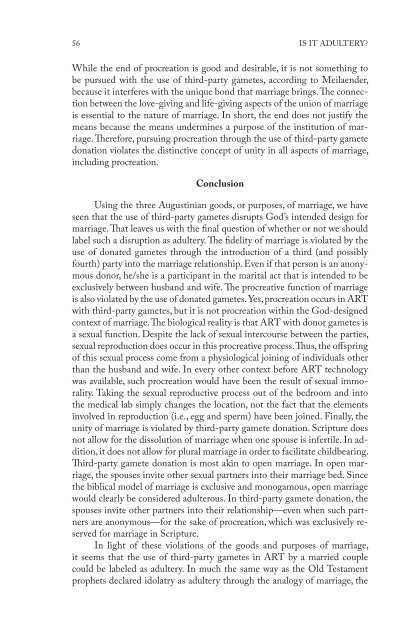experienced praying donating
SWJT%2059.1_Lenow
SWJT%2059.1_Lenow
Create successful ePaper yourself
Turn your PDF publications into a flip-book with our unique Google optimized e-Paper software.
56 IS IT ADULTERY?<br />
While the end of procreation is good and desirable, it is not something to<br />
be pursued with the use of third-party gametes, according to Meilaender,<br />
because it interferes with the unique bond that marriage brings. The connection<br />
between the love-giving and life-giving aspects of the union of marriage<br />
is essential to the nature of marriage. In short, the end does not justify the<br />
means because the means undermines a purpose of the institution of marriage.<br />
Therefore, pursuing procreation through the use of third-party gamete<br />
donation violates the distinctive concept of unity in all aspects of marriage,<br />
including procreation.<br />
Conclusion<br />
Using the three Augustinian goods, or purposes, of marriage, we have<br />
seen that the use of third-party gametes disrupts God’s intended design for<br />
marriage. That leaves us with the final question of whether or not we should<br />
label such a disruption as adultery. The fidelity of marriage is violated by the<br />
use of donated gametes through the introduction of a third (and possibly<br />
fourth) party into the marriage relationship. Even if that person is an anonymous<br />
donor, he/she is a participant in the marital act that is intended to be<br />
exclusively between husband and wife. The procreative function of marriage<br />
is also violated by the use of donated gametes. Yes, procreation occurs in ART<br />
with third-party gametes, but it is not procreation within the God-designed<br />
context of marriage. The biological reality is that ART with donor gametes is<br />
a sexual function. Despite the lack of sexual intercourse between the parties,<br />
sexual reproduction does occur in this procreative process. Thus, the offspring<br />
of this sexual process come from a physiological joining of individuals other<br />
than the husband and wife. In every other context before ART technology<br />
was available, such procreation would have been the result of sexual immorality.<br />
Taking the sexual reproductive process out of the bedroom and into<br />
the medical lab simply changes the location, not the fact that the elements<br />
involved in reproduction (i.e., egg and sperm) have been joined. Finally, the<br />
unity of marriage is violated by third-party gamete donation. Scripture does<br />
not allow for the dissolution of marriage when one spouse is infertile. In addition,<br />
it does not allow for plural marriage in order to facilitate childbearing.<br />
Third-party gamete donation is most akin to open marriage. In open marriage,<br />
the spouses invite other sexual partners into their marriage bed. Since<br />
the biblical model of marriage is exclusive and monogamous, open marriage<br />
would clearly be considered adulterous. In third-party gamete donation, the<br />
spouses invite other partners into their relationship—even when such partners<br />
are anonymous—for the sake of procreation, which was exclusively reserved<br />
for marriage in Scripture.<br />
In light of these violations of the goods and purposes of marriage,<br />
it seems that the use of third-party gametes in ART by a married couple<br />
could be labeled as adultery. In much the same way as the Old Testament<br />
prophets declared idolatry as adultery through the analogy of marriage, the


